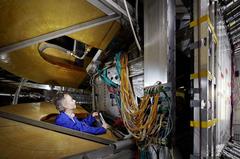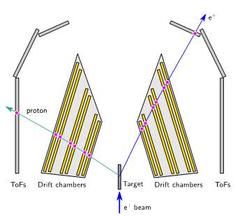URL: https://www.desy.de/news/news_search/index_eng.html
Breadcrumb Navigation
DESY News: OLYMPUS experiment publishes first results for proton puzzle
News
News from the DESY research centre
OLYMPUS experiment publishes first results for proton puzzle
The international OLYMPUS Collaboration this week published their first results in the journal Physical Review Letters. In 2012, the OLYMPUS detector made measurements at the DORIS storage ring to study a problem observed in electron-proton scattering. “The publication marks the culmination of a seven year research project to resolve a puzzling discrepancy in measurements of the proton form factors: GE and GM, which describe the electric and magnetic charge distributions inside the proton,” says Douglas Hasell from the Massachusetts Institute of Technology (MIT) in Boston, who is the spokesperson for some 55 OLYMPUS scientists from 13 institutions. The experiment produced precise measurements of the ratio between positron-proton and electron-proton elastic scattering to investigate the role of two-photon exchange in electron-proton scattering.

DESY scientist Uwe Schneekloth during construction of the OLYMPUS dectector within the big toroid coils of the experiment. In the background on the left one can see the DORIS beampipe connected to the target cell, on the right the time of flight chambers (photo: DESY/ H. Müller-Elsner).
The big advantage of this combination was that DORIS could alternate between high intensity beams of electrons and their antiparticles, positrons, incident on the protons in a hydrogen gas target. In multi-photon exchange, differences arise depending on whether the protons were struck with electrons or positrons. “Using DORIS, we were able to switch very rapidly between electron and positron operation, which considerably reduces the systematic error in the measurements,” explains Uwe Schneekloth, a researcher at DESY who is the deputy spokesperson for the collaboration. “Thanks to the amazing support of DESY’s accelerator team, which kept DORIS up and running over the Christmas break and even implemented the top-up mode of operation for DORIS, we were able to collect a large amount of valuable data over our short operating time in spite of some technical challenges.”

“The findings from OLYMPUS will lead to a marked advance in our understanding of the proton,” explains Joachim Mnich, Director for particle and astroparticle physics at DESY. “I would like to congratulate the OLYMPUS Collaboration, whose experiment has supplied the most accurate data on this effect that will be available for the foreseeable future.”



